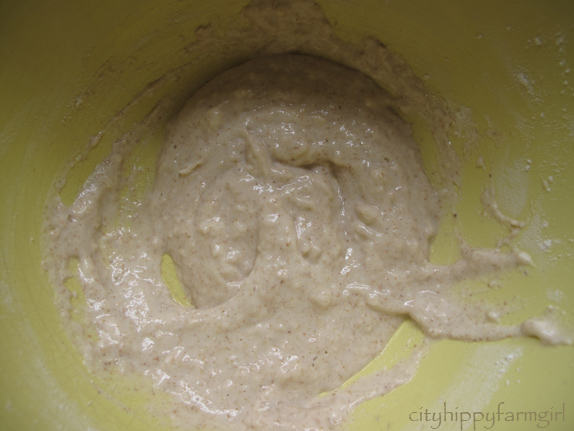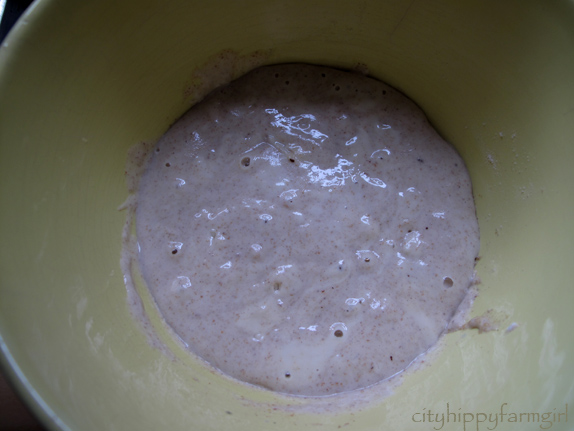Over four years ago, I made a sourdough starter and have been happily dibble dabbling in bags of flour ever since. I love it and my family loves it and it’s easily become a regular part of our life.
When I initially started, I really had no idea what I was doing. I read and read, confusing myself by all the different methods that people made their beautiful loaves by. I decided like most of my baking, I just need to play, play until I came up with a method that suited me and with that I could then find a rhythm that I could follow.
The whole bready process is still an evolving one. Our family needs change and along with it so does my weekly baking. I am by no means an expert but I do enjoy the whole floury process of it all.
When you are first starting out there seems to be a lot to understand with bread baking. My advice is; do some reading and once you’ve got a vague idea of what you are doing, jump in. Learn by your mistakes and keep fiddling and tweaking until you get to a loaf that you and your loved ones all enjoy, (I’m still learning too!)
Now as long your starter isn’t grey, smell like vomit, smell like acetone, growing purple mould, or simply just dead, you should be able to bake with it. Ready to get started?
You’ll need a ceramic bowl, an old plastic shopping bag, rye and bakers flour, tap water. Try to feed your starter at approximately the same time each day.
Day one- Added 50g rye flour and 50mls water together. Weighs 100g.
Smells like- rye flour and water
Looks like- rye flour and water
Day two– First feed. Adding 50g rye flour and 50mls water to flour and water mixture. Now weighs 200g.
Smells like- rye flour and water.
Looks like- rye flour and water.
Day Three– Second feed. Adding 100g white flour and 100mls water to the mixture. Now weighs 400g.
Smells like- Fruity and floury, things are starting… Go on, take another smell to make sure.
Looks like- It’s puffed up a little, it looks a little stringy when you stir through the feed. That tiny black speck in the middle is a bubble.
Day Four– Third feed. Adding 200g of white flour and 200mls water. Now weighs 800g.
Smells like- a bit fruity, a bit yeasty, a bit…?
Looks like- more bubbles, with a few white streaks with the change of the flour.
Day Five– Fourth feed. First I need to divide the starter, (otherwise it will be too big- this just goes in the compost). Take it back down to 100g of starter and add- 50g white flour and 50mls water. Now weighs 200g. (This is repeating Day Two)
Smells like- A bit fruity, a bit yeasty, nothing unpleasant at all.
Looks like- Bubbles. Lots of action going on now.
Day Six– Fifth feed. Repeating Day Three. 100g of flour and 100mls water, now weighs 400g.
Smells like- fruity/yeasty kind of action.
Looks like- bubbles, a whole lot of them.
Day Seven– Changes. The smell of the starter becomes slightly more acidic smelling. As long as there are plenty of bubbles happening, you can decide whether you want to keep feeding it and bake with the discarded amount of starter or store it in the fridge, (this is now your mother.) At this stage your starter is a little vulnerable as it’s still new, but the older and more feeds it has, the stronger it will be.
By storing the mother in the fridge you slow down the fermentation process. (I store mine in the fridge, feeding and baking with it twice a week.) Before you want to make up a dough, you will need to refresh your starter at least 3 times within 36 hours, (eg. 7am, 7pm, 7am.) Longer, if you have left it for any length of period.
Simple, Everyday Sourdough Recipe here.
If you are interested in going further with sourdough, below are some links of interest with other peoples methods, troubleshooting, and tips on how to maintain a starter below. There can be a lot of information to take in, but it’s a versatile beast that works in many mysterious ways for many different people.
So grab a cup of tea, have a read, get ready to your hands dirty and most importantly happy baking.
Helpful baking sites…











Thanks so much for the starter recipe always wanted to try it.
LikeLike
Thanks for the recipe and the detailed explanation. I hope I can be successful!
LikeLike
Pingback: 5 things my kitchen would be completely lost without | cityhippyfarmgirl
Hi Hippycity chick……I’m making my starter right now….do you just cover it loosely with a plastic shopping bag? or is clingwrap….i don’t want it to dry out. Enjoying your blog. Rhonda
LikeLike
Either one Rhonda. You don’t want any air getting to it to form a skin and drying out. If you had a large enough glass jar that would also do the trick. Good luck!
LikeLike
Thanks for the instructions! I tried it out and it worked really well. (My first attempt a few years ago failed miserably). I put my starter on the kitchen bench next to my kombucha I’m brewing…maybe that helped with the fermentation. I used a Nourishing Traditions spelt recipe for my loaf. Really good!
LikeLike
Hi, thank you for photos and descriptions. When feeding the starter do you manually mix in the flour and water till combined or just add to starter and let them do their thing?
Cheers
LikeLike
Give it a bit of a stir Jane. You don’t have to do a lot, just until it’s all combined will work fine. 20 secs?
LikeLike
Thank you!! Time to stop procrastinating and give this a go.
LikeLike
Am absolutely in love with this starter, never been able to make a mother before, but when you say refresh three times before use,(sorry I may be a little dumb), but how do you do that?
LikeLike
Give it a feed Coralee- following the same pattern you’ve been following eg. 100g starter+ 100g mixture of flour and water. If your starter has been resting in the fridge for any length of time this strengthens it again and bulks up the amount to make your dough with. If you are making it straight from the end of day 7 you won’t need to do this, (just remember to put some aside as your mother!)
Hope that helps.
LikeLike
Pingback: Top 13 Eco friendly Gift Ideas | cityhippyfarmgirl
Can I use normal flour, I live half hour away from shops and have everything to start except bakers flour
Thank you
LikeLike
Should be fine Alison. Bakers flour has just has a little more protein within it. Good luck with your starter!
LikeLike
Pingback: The Crumpet Trumpet | cityhippyfarmgirl
Ok I’m up to day seven and it has worked so well. I’m going to feed with 100 and 100 today and pop in the fridge. But do you have any recommendations of what to read next and how to maintain the sour dough. And how much do you keep back as the mother when you bake etc.
Thank you for such a great resource.
LikeLike
Just bake with it regularly Jess until it gets a little older. The more baking it gets, and regular use, the more robust it will be (it is a little vulnerable initially.)
Before you want to make up a dough, you will need to refresh your starter at least 3 times within 36 hours, (eg. 7am, 7pm, 7am.) Longer, if you have left it for any length of period. You can keep back any amount for you mother, it really is just what suits you. I usually do about 200g.
And when you need an easy recipe just click here 🙂
LikeLike
Pingback: Adventures In Bread |
Hi there, just wondering if it has to start with rye flour as I’m intolerant to rye (yay me)? I have spelt flour, buckwheat flour and plain (not bakers) flour as options to start with. Thanks
LikeLike
oh boo, that’s a bugger. Yep give the plain flour a go, and spelt should be fine too. I haven’t had great results with the buckwheat but I haven’t thoroughly looked into either. Good luck with your baking!
LikeLike
Pingback: Plastic Free July | cityhippyfarmgirl
I’ve taken my around 6 week-old starter out of the fridge and added flour and water and now it has LOTS of bubbles! And it has a distinctly sour smell. Does that mean it’s too old?
LikeLike
Pingback: Resolutions for the New Year –
Thanks so much for the detailed explanation. So many other instructions, keep telling me to halve the starter everyday and i could not figure out how i would ever get to a weight big enough to bake with. I have a bubbly yeasty smelling starter that I’ve been feeding for 7 days now that weighs 200gm so I won’t halve to today just add 100g flour and water and see where that takes me. I was getting so frustrated as well, i am using Spelt flour which isn’t cheap and absolutely burning through it! It’s my third attempt at a starter, i live in Queensland and it’s summer, which i now realise was just too hot for it, so i have but it in an esky with one ice block next to it. That’s my Sourdough journey so far….
LikeLike
Pingback: How to dry your sourdough starter, and bring it back to LIFE again! | cityhippyfarmgirl
Do you have to use rye? Can i use spelt instead? for the starter?
LikeLike
Not sure Elisha? My recipe is for rye is known to be great for kickstarting things along.
LikeLike
Day 3 and my starter has little bits of white fluff, only just noticeable, i am thinking mould??? It had little air holes but the mixture has been very thick from day 1, it was not at all like goo, more like very thick paste. I have it stored in the pantry with the Kombucha. South East QLD so maybe too warm??
LikeLike
A thick paste should still work Ash, hot weather is a pain though and can be tricky to work with. Keep at it for a little longer but also be guided by your nose. If it smells funky, it probably is funky.
LikeLike
Thanks Brydie, Im now off and away. Day 8 (I did need to start again) and the starter is rising and falling very predictably. Now i am just trying to work out ratios so that i can bake two loaves a week for the family. Sometimes maybe one more if someones requests one. I have increased by ratio to 100:250:250. Is this way too much? Am i wasting flour? Should my ratio of starter (100) start to decrease and i increase my flour and water. Is this how it works? Im confused as to how much starter i need to keep. Sorry for the long winded post. Hope this makes sense. Thank you so much.
Ash
LikeLike